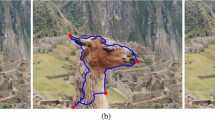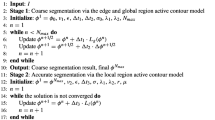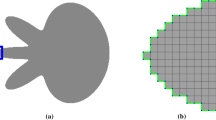Abstract
This paper investigates generic region-based segmentation schemes using area-minimization constraint and background modeling, and develops a computationally efficient framework based on level lines selection coupled with biased anisotropic diffusion. A common approach to image segmentation is to construct a cost function whose minima yield the segmented image. This is generally achieved by competition of two terms in the cost function, one that punishes deviations from the original image and another that acts as a regularization term. We propose a variational framework for characterizing global minimizers of a particular segmentation energy that can generates irregular object boundaries in image segmentation. Our motivation comes from the observation that energy functionals are traditionally complex, for which it is usually difficult to precise global minimizers corresponding to “best” segmentations. In this paper, we prove that the set of curves that minimizes the basic energy model under concern is a subset of level lines or isophotes, i.e. the boundaries of image level sets. The connections of our approach with region-growing techniques, snakes and geodesic active contours are also discussed. Moreover, it is absolutely necessary to regularize isophotes delimiting object boundaries and to determine piecewise smooth or constant approximations of the image data inside the objects boundaries for vizualization and pattern recognition purposes. Thus, we have constructed a reaction-diffusion process based on the Perona-Malik anisotropic diffusion equation. In particular, a reaction term has been added to force the solution to remain close to the data inside object boundaries and to be constant in non-informative regions, that is the background region. In the overall approach, diffusion requires the design of the background and foreground regions obtained by segmentation, and segmentation of the adaptively smoothed image is performed after each iteration of the diffusion process. From an application point of view, the sound initialization-free algorithm is shown to perform well in a variety of imaging contexts with variable texture, noise and lighting conditions, including optical imaging, medical imaging and meteorological imaging. Depending on the context, it yields either a reliable segmentation or a good pre-segmentation that can be used as initialization for more sophisticated, application-dependent segmentation models.
Similar content being viewed by others
Explore related subjects
Discover the latest articles, news and stories from top researchers in related subjects.References
Acton, S. and Mukherjee, D. 2000. Scale space classification using area morphology. IEEE Trans. Image Processing, 9(4):623–635.
Alvarez, L. and Esclarin, J. 1997. Image quantization using reaction-diffusion equations. SIAM Journal of Applied Mathematics, 57(1):153–175.
Alvarez, L., Gousseau, Y., and Morel, J. 1999. Scales in natural images and a consequence on their bounded variation. In Int. Conf. on Scale-Space Theories Comp. Vis., Kerkyra, Greece, pp. 247–258.
Alvarez, L., Guichard, F., Lions, P., and Morel, J. 1993. Axioms and fundamental equations in image processing. Arch. Rational Mech. Aanalysis, 16(9):200–257.
Alvarez, L., Lions, P., and Morel, J. 1992. Image selective smoothing and edge detection by non-linear diffusion—2. SIAM J. Numerical Analysis, 29(3):845–866.
Alvarez, L. and Mazorra, L. 1994. Signal and image restoration using shock filters and anisotropic diffusion. SIAM Journal of Numerical Analysis, 31(2):590–605.
Amadieu, O., Debreuve, E., Barlaud, M., and Aubert, G. 1999. Simultaneous inward and outward curve evolution. In Int. Conf. on Image Processing, Kobe, Japan.
Beaulieu, J. and Goldberg, M. 1989. Hierarchy in picture segmentation: A stepwise optimization approach. IEEE Trans. Patt. Anal. and Mach. Int., 11(2):150–163.
Black, M. and Rangarajan, A. 1996. On the unification of line processes, outlier rejection, and robust statistics with applications in early vision. Int. J. Computer Vision, 19(1):57–92.
Black, M. and Sapiro, G. 1999. Edges as outliers: Smoothing using local image statistics. In Int. Conf. on Scale-Space Theories Comp. Vis., Kerkyra, Greece, pp. 259–270.
Black, M., Sapiro, G., Marimont, D., and Heeger, D. 1998. Robust anisotropic diffusion. IEEE Trans. Image Processing, 7(3):421–432.
Blake, A. and Zisserman, A. 1987. Visual Reconstruction. MIT Press: Cambridge, Mass.
Caselles, V., Coll, B., and Morel, J. 1999. Topographic maps and local contrast changes in natural images. Int J. Computer Vision, 33(1):5–27.
Caselles, V., Kimmel, R., and Sapiro, G. 1997. Geodesic active contours. Int J. Computer Vision, 22(1):61–79.
Caselles, V., Morel, J., Sapiro, G., and Tannenbaum, A. 1998. Special issue on partial differential equations and geometry-driven diffusion in image processing and analysis. IEEE Trans. Image Processing, 7(3):269–473.
Catte, F., Lions, P., Morel, J., and, T., C. 1992. Image selective smoothing and edge detection by non-linear diffusion. SIAM J. Numerical Analysis, 29(1):182–193.
Chan, T. and Vese, L. 1999. Active contour model without edges. In Int. Conf. on Scale-Space Theories Comp. Vis., Kerkyra, Greece, pp. 141–151.
Charbonnier, P., Blanc-Feraud, L., Aubert, G., and Barlaud, M. 1997. Deterministic edge-preserving regularization in computed imaging. IEEE Trans. Image Processing, 6(2):298–311.
Chesnaud, C., Réfrégier, P., and Boulet, V. 2000. Statistical region snake-based segmentation adapted to different physical models. IEEE Trans. Patt. Anal. and Mach. Int., 21(11):1145–1157.
Chu, C. and Agarwal, J. 1993. The integration of image segmentation maps using region and edge information. IEEE Trans. Patt. Anal. and Mach. Int., 15:1242–1252.
Cohen, L. 1991. On active contour models and balloons. CVGIP: Image Understanding, 53(2):211–218.
Cohen, L. 1996. Deformable curves and surfaces in image analysis. In Int. Conf. Curves and Surfaces, Chamonix, France.
Darrell, T. and Pentland, A. 1995. Cooperative robust estimation using layers of support. IEEE Trans. Patt. Anal. and Mach. Int., 17(5):474–487.
Deriche, R. 1987. Using canny's criteria to derive a recursively implemented optimal edge detector. Int J. Computer Vision, 2(1):167–187.
Figueiredo, M., Leitao, J., and Jain, A. 2000. Unsupervised contour representation and estimation using b-plines and mininim description length criterion. IEEE Trans. Image Processing, 6(9):1075–1087.
Froment, J. 2000. Perceptible level lines and isoperimetric ratio. In Int. Conf. on Image Processing, Vancouver, Canada.
Geiger, D. and Yuille, A. 1991. A common framework for image segmentation. Int. J. Computer Vision, 6(3):1186–1191.
Geman, S. and Geman, D. 1984. Stochastic relaxation, gibbs distributions, and the bayesian restoration of images. IEEE Trans. Patt. Anal. and Mach. Int., 6(6):721–741.
Grenander, U. and Miller, M. 1994. Representations of knowledge in complex systems. J. Royal Statistical Society, Series B, 56(4):549–603.
Ishikawa, H. and Geiger, D. 1998. Segmentation by grouping junc-tions. In Comp. Vis. and Patt. Rec., Santa Barbara, CA.
Istas, J. 1997. Statistics of Processes and Signal-Image Segmentation. University of Paris VII.
Jermyn, I. and Ishikawa, H. 1999. Globally optimal regions and boundaries. In Int. Conf. on Comp. Vis., Kerkyra, Greece, pp. 904–910.
Kass, M., Witkin, A., and Terzopoulos, D. 1987. Snakes: Active contour models. Int. J. Computer Vision, 12(1):321–331.
Kichenesamy, S., Kumar, A., Olver, P., and Yezzi, A. 1996. Conformal curvature flows: From transition to active contours. Archive for Rational Mechanics and Anal., 134:275–301.
Koepfler, G., Lopez, C., and Morel, J. 1994. A multiscale algorithm for image segmentation by variational method. SIAM J. Numerical Analysis, 31(1):282–299.
Kornprobst, P., Deriche, R., and Aubert, G. 1997. Image coupling, restoration and enhancement via pde's. In Int. Conf. on Image Processing, Santa Barbara, USA, pp. 458–461.
Leclerc, Y. 1989. Constructing simple stable descriptions for image partitioning. Int. J. Computer Vision, 3:73–102.
Malladi, M. and Sethian, J. 1996. Image processing: Flows under min/max curvature and mean curvature. Graphical Models and Image Processing, 58(2):127–141.
Matheron, G. 1975. Random Sets and Integral Geometry. John Wiley: New York.
Merriman, B., Bebce, J., and Osher, S. 1994. Motion of multiple junctions: A level set approach. J. Comput. Physics, 112(2):334–363.
Monasse, P. and Guichard, F. 2000. Fast computation of a contrast-invariant image representation. IEEE Trans. Image Processing, 9(5):860–872.
Morel, J. and Solimini, S. 1994. Variational Methods in Image Segmentation. Birkhauser.
Mumford, D. 1994. The bayesian rationale for energy functionals. In Geometry-Driven Diffusion in Computer Vision, Bart Romeny (Ed.). Kluwer Academic: Dordrecht, pp. 141–153.
Mumford, D. and Shah, J. 1989. Optimal approximations by piecewise smooth functions and variational problems. Com. on Pure and applied Mathematics, 42(5):577–685.
Nitzberg, N. and Mumford, D. 1990. The 2.1d sketch. In Int. Conf. on Comp. Vis., Osaka, Japan, pp. 138–144.
Nordström, K. 1990. Biased anisotropic diffusion: A unified regularization and diffusion approach to edge detection. Image and Vision Computing, 8(4):318–327.
Olsen, O. 1996. Multi-scale segmentation of grey-scale images. In Technical Report DIKU Nr. 96/30, ISSN 0107-8283, Department of Computer Science, University of Copenhagen.
Osher, S. and Sethian, J. 1988. Fronts propagating with curvature dependent speed: Algorithms based on the hamilton-jacobi formulation. J. Computational Physics, 79:12–49.
Paragios, N. and Deriche, R. 2000. Coupled geodesic active regions for image segmentation: A level set approach. In Euro. Conf. on Comp. Vis., Dublin, Ireland.
Pavlidis, T. and Liow, Y. 1990. Integrating region growing and edge detection. IEEE Trans. Patt. Anal. and Mach. Int., 12:225–233.
Perona, P. and Malik, J. 1990. Scale-space and edge detection using anisotropic diffusion. IEEE Trans. Patt. Anal. and Mach. Int., 12(7):629–639.
Rougon, N. and Preteux, F. 1995. Controlled anisotropic diffusion. In Proc. SPIE Conf. on Nonlinear Image Processing VI, San Jose, CA, vol. 2424, pp. 329–340.
Rougon, N. and Preteux, F. 1998. Directional adaptive deformable models for segmentation. J. of Electronic Imaging, 7(1):231–256.
Rousseeuw, P. and Leroy, A. 1987. Robust Regression and Outlier Detection. Wiley Series in Probability and Mathematical Statistics, Wiley.
Salembier, P. and Serra, J. 1995. Flat zones filtering, connected operators, and filters by reconstruction. IEEE Trans. Image Processing, 4(8):1153–1160.
Samson, C., Blanc-Féraud, L., Aubert, G., and Zerubia, J. 1999. A level set model for image classification. In Int. Conf. on Scale-Space Theories Comp. Vis., Kerkyra, Greece, pp. 306–317.
Schnörr, C. 1998. A study of a convex variational diffusion approach for image segmentation and feature extraction. J. Math. Imaging and Vision, 3(8):271–292.
Sethian, J. 1996. Level Sets Methods: Evolving Interfaces in Geometry, Fluid Mechanics, Computer Vision, and Material Science. Cambridges University Press: Cambridge.
Ter Haar Romeny, B. 1994. Geometry-Driven Diffusion in Computer Vision. Kluwer Academic Publishers: Dordrecht, The Netherlands.
Vincent, L. and Soille, P. 1991. Watershed in digital spaces: An efficient algorithm based on immersion simulations. IEEE Trans. Patt. Anal. and Mach. Int., 13(6):583–598.
Wang, J. 1998. Stochastic relaxation on partitions with connected components and its application to image segmentation. IEEE Trans. Patt. Anal. and Mach. Int., 20(6):619–636.
Weickert, J. 1998a. Anisotropic Diffusion in Image Processing. Teubner-Verlag: Stuttgart, Germany.
Weickert, J. 1998b. Fast segmentation methods based on partial differential equations and the watershed transformation. In Mustererkennung 1998, P. Levi, R.-J. Ahlers, F. May, and M. Schwanz (Eds.). Springer: Berlin, pp. 93–100.
Yezzi, A., Tsai, A., and Willsky, A. 1999. A statistical approach to snakes for bimodal and trimodal imagery. In Int. Conf. on Comp. Vis., Kerkyra, Greece, pp. 898–903.
You, Y., Xu, W., Tannenbaum, A., and Kaveh, M. 1996. Behavioral analysis of anisotropic diffusion in image processing. IEEE Trans. Image Processing, 5:1539–1553.
Younes, L. 2000. Calibrating parameters of cost functionals. In Euro. Conf. on Comp. Vis., Dublin, Ireland.
Zhu, S. and Mumford, D. 1997. Prior learning and gibbs reaction-diffusion. IEEE Trans. Patt. Anal. and Mach. Int., 19(11):1236–1250.
Zhu, S. and Yuille, A. 1996. Region competition: Unifying snakes, region growing, and bayes/mdl for multiband image segmentation. IEEE Trans. Patt. Anal. and Mach. Int., 18(9):884–900.
Author information
Authors and Affiliations
Rights and permissions
About this article
Cite this article
Kervrann, C., Hoebeke, M. & Trubuil, A. Isophotes Selection and Reaction-Diffusion Model for Object Boundaries Estimation. International Journal of Computer Vision 50, 63–94 (2002). https://doi.org/10.1023/A:1020276319925
Issue Date:
DOI: https://doi.org/10.1023/A:1020276319925




